Research on the Effect of the Outlet Throttle Diameter Deviation on the Pressure Relief Rate of the Injector Control Valve
Abstract
:1. Introduction
2. Basic Mathematical Model
2.1. Cavitation Model
2.2. Mass Flow Model
3. Numerical Modeling and Validation
3.1. Geometry Structure and Boundary Condition Settings of Spherical Control Valve
3.2. Mesh Independence Verification
3.3. Model Validation
4. Results and Discussion
4.1. Sensitivity Analysis of Pressure Relief Rate under the Same Rail Pressure
4.2. Sensitivity Study of Pressure Relief Rate under Different Rail Pressures
4.2.1. Analysis of The Influence Law of Rail Pressure on Hydraulic Characteristics
4.2.2. Coupling Effect of Rail Pressure and Outlet Throttle on Pressure Relief Rate
5. Conclusions
Author Contributions
Funding
Acknowledgments
Conflicts of Interest
References
- Agarwal, A.K.; Kumar, V.; Kalwar, A.A. Fuel injection strategy optimisation and experimental performance and emissions evaluation of diesel displacement by port fuel injected methanol in a retrofitted mid-size genset engine prototype. Energy 2022, 248, 123593. [Google Scholar] [CrossRef]
- Zacherl, F.; Wopper, C.; Schwanzer, P.; Rabl, H. Potential of the Synthetic Fuel Oxymethylene Ether (OME) for the Usage in a Single-Cylinder Non-Road Diesel Engine: Thermodynamics and Emissions. Energies 2022, 15, 7932. [Google Scholar] [CrossRef]
- Li, H.D.; Xing, Y.L.; Ge, Q.S. The influence of lubricating oil on deposits formation in a diesel engine under the operation condition of high power density. Lubr. Sci. 2013, 25, 441–451. [Google Scholar]
- Leng, L.; Qiu, H.J.; Li, X.N.; Zhong, J.; Shi, L.; Deng, K.Y. Effects on the transient energy distribution of turbocharging mode switching for marine diesel engines. Energy 2022, 249, 123746. [Google Scholar] [CrossRef]
- Carlo, B.; Gabriele, D.B.; Giacomo, B. Experimental analysis of functional requirements to exceed the 100kw/l in high-speed light-duty diesel engines. Fuel 2017, 207, 591–601. [Google Scholar]
- Ranjeet, K.R.; Rashmi, R.S. Effective power and effective power density analysis for water in diesel emulsion as fuel in diesel engine performance. Energy 2019, 180, 893–902. [Google Scholar]
- Gao, Z.G.; Li, H.M.; Xu, C.L.; Li, G.X.; Wang, M. Control Strategy Based on Flow Conservation Equation for High-pressure Common Rail System. Int. J. Automot. Technol. 2022, 23, 793–803. [Google Scholar] [CrossRef]
- Catania, A.E.; Ferrari, A. Development and performance assessment of the new-generation CF fuel injection system for diesel passenger cars. Appl. Energy 2011, 91, 483–495. [Google Scholar] [CrossRef]
- Hu, Y.; Yang, J.G.; Hu, N. Experimental study and optimization in the layouts and the structure of the high-pressure common-rail fuel injection system for a marine diesel engine. Int. J. Engine Res. 2020, 22, 1850–1871. [Google Scholar] [CrossRef]
- Seoyeon, A.; Jungkwon, P.; Jongphil, W.; Hyunsoo, K.; Insan, K.; Yongseok, C.; Sukshin, S. An analytical FEM-based study of the drawing process of an ultra-high-pressure common-rail fuel tube. J. Mech. Sci. Technol. 2017, 31, 3389–3396. [Google Scholar]
- Wang, L.; Li, G.X.; Xu, C.L.; Xi, X.; Wu, X.J.; Sun, S.P. The Investigation of Geometric Parameters on the Injection Characteristic of the High Pressure Common-Rail Injector. J. Eng. Gas Turbines Power 2019, 141, 022801. [Google Scholar] [CrossRef]
- MA, F.K.; ZHAO, C.L.; ZHANG, F.J. Study of Hydraulic Response Characteristics of Common Rail Injector. In Proceedings of the 2013 International Conference on Frontiers of Environment, Energy and Bioscience (ICFEEB 2013), Beijing, China, 24–25 October 2013; pp. 687–692. [Google Scholar]
- Khandal, S.V.; Banapurmath, N.R.; Gaitonde, V.N. Effect of exhaust gas recirculation, fuel injection pressure and injection timing on the performance of common rail direct injection engine powered with honge biodiesel (BHO). Energy 2017, 139, 828–841. [Google Scholar] [CrossRef]
- Payri, R.; Salvador, F.J.; Gimeno, J.; Venegas, O. Study of cavitation phenomenon using different fuels in a transparent nozzle by hydraulic characterization and visualization. Exp. Therm. Fluid Sci. 2013, 44, 235–244. [Google Scholar] [CrossRef] [Green Version]
- Frédéric, B.; Patrice, S. Impact of physical properties of biodiesel on the injection process in a common-rail direct injection system. Energy Convers. Manag. 2009, 50, 2905–2912. [Google Scholar]
- Salvador, F.J.; Gimeno, J.; De la Morena, J.; Carreres, M. Using one-dimensional modeling to analyze the influence of the use of biodiesels on the dynamic behavior of solenoid-operated injectors in common rail systems: Results of the simulations and discussion. Energy Convers. Manag. 2011, 54, 122–132. [Google Scholar] [CrossRef]
- Jinwook, L.; Kyoungdoug, M. Effects of Needle Response on Spray Characteristics in High Pressure Injector Driven by Piezo Actuator for Common-Rail Injection System. J. Mech. Sci. Technol. 2005, 19, 1194–1205. [Google Scholar]
- Lan, Q.; Fan, L.Y.; Bai, Y.; Gu, Y.Q.; Wen, L.M. Correlation analysis upon the influential factors related to the dynamic response characteristics of pressure amplification piston in the fuel system for a low-speed diesel engine. Fuel 2020, 276, 118052. [Google Scholar] [CrossRef]
- Plamondon, E.; Seers, P. Parametric study of pilot–main injection strategies on the performance of a light-duty diesel engine fueled with diesel or a WCO biodiesel–diesel blend. Fuel 2019, 236, 1273–1281. [Google Scholar] [CrossRef]
- Chen, G.J.; Chen, C.; Yuan, Y.M.; Zhu, L.J.; Lou, X. The Effect of the Structure and Parameters of Diesel Injector on Atomization Characteristics. Integr. Ferroelectr. 2021, 219, 145–159. [Google Scholar] [CrossRef]
- Hu, Q.; Wu, S.F.; Stottler, S.; Raghupathi, R. Modelling of Dynamic Responses of an Automotive Fuel Rail System, PART I: Injector. J. Sound Vib. 2001, 245, 801–814. [Google Scholar] [CrossRef]
- Duan, L.; Yuan, S.Q.; Hu, L.F.; Yang, W.M.; Yu, J.D.; Xia, X.L. Injection performance and cavitation analysis of an advanced 250 MPa common rail diesel injector. Int. J. Heat Mass Transf. 2016, 93, 388–397. [Google Scholar] [CrossRef]
- Wang, C.; Li, G.X.; Sun, Z.Y.; Wang, L.; Sun, S.P.; Gu, J.J.; Wu, X.J. Effects of structure parameters on flow and cavitation characteristics within control valve of fuel injector for modern diesel engine. Energy Convers. Manag. 2016, 124, 104–115. [Google Scholar] [CrossRef]
- Ren, R.N.; Su, T.X.; Ma, F.K.; Wu, X.J.; Xu, C.L.; Zhao, X. Study of the influence laws of the flow and cavitation characteristics in an injector control valve. Energy Sci. Eng. 2022, 10, 932–950. [Google Scholar] [CrossRef]





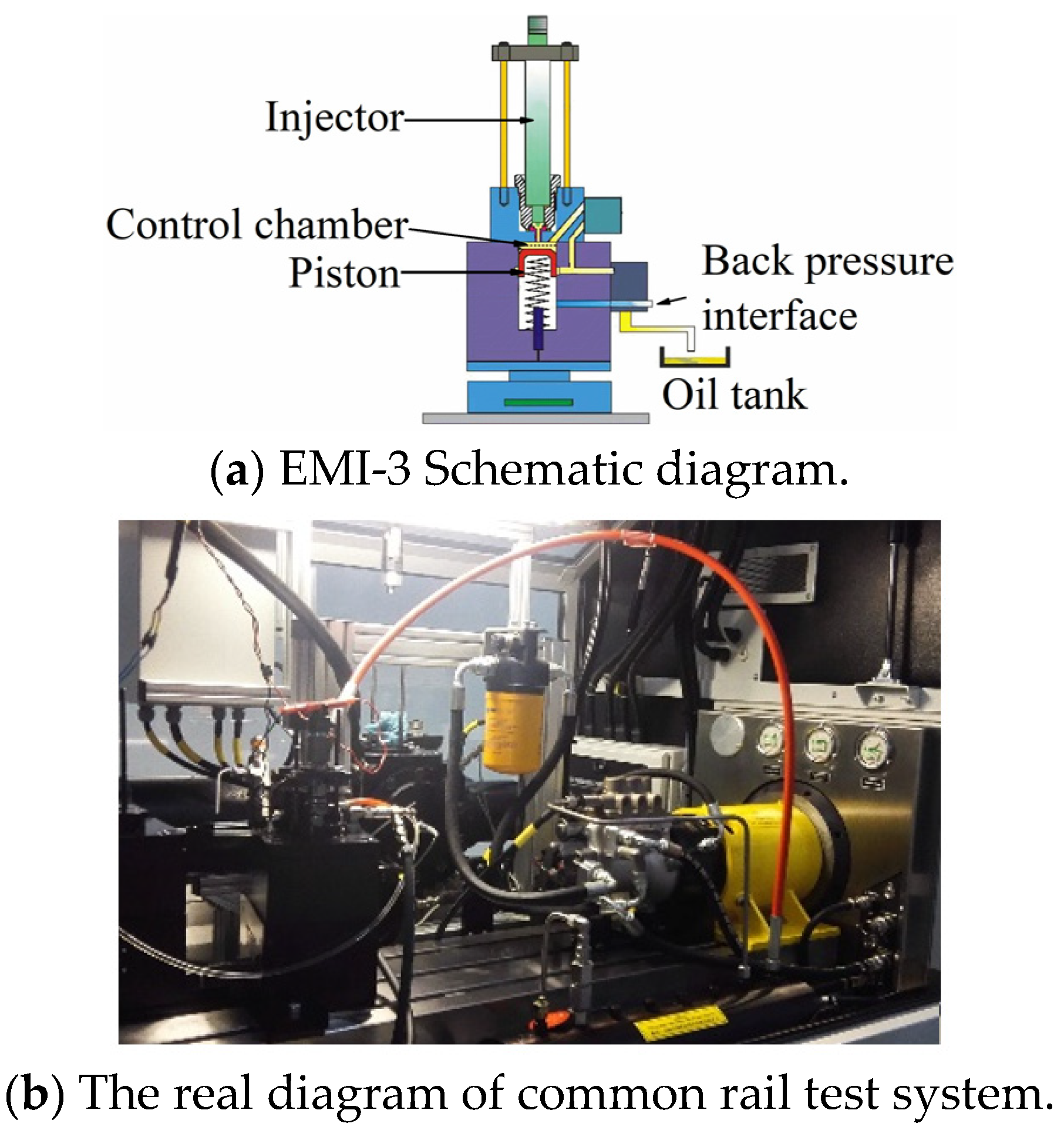


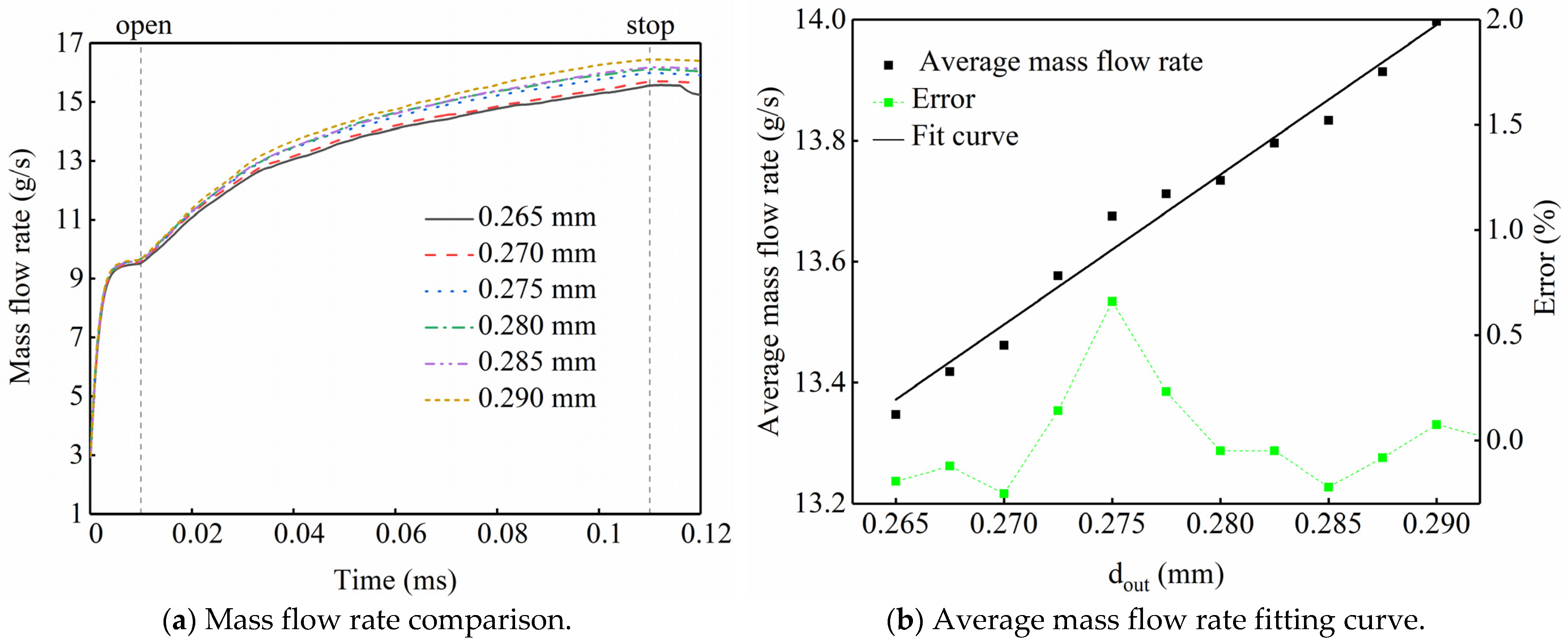
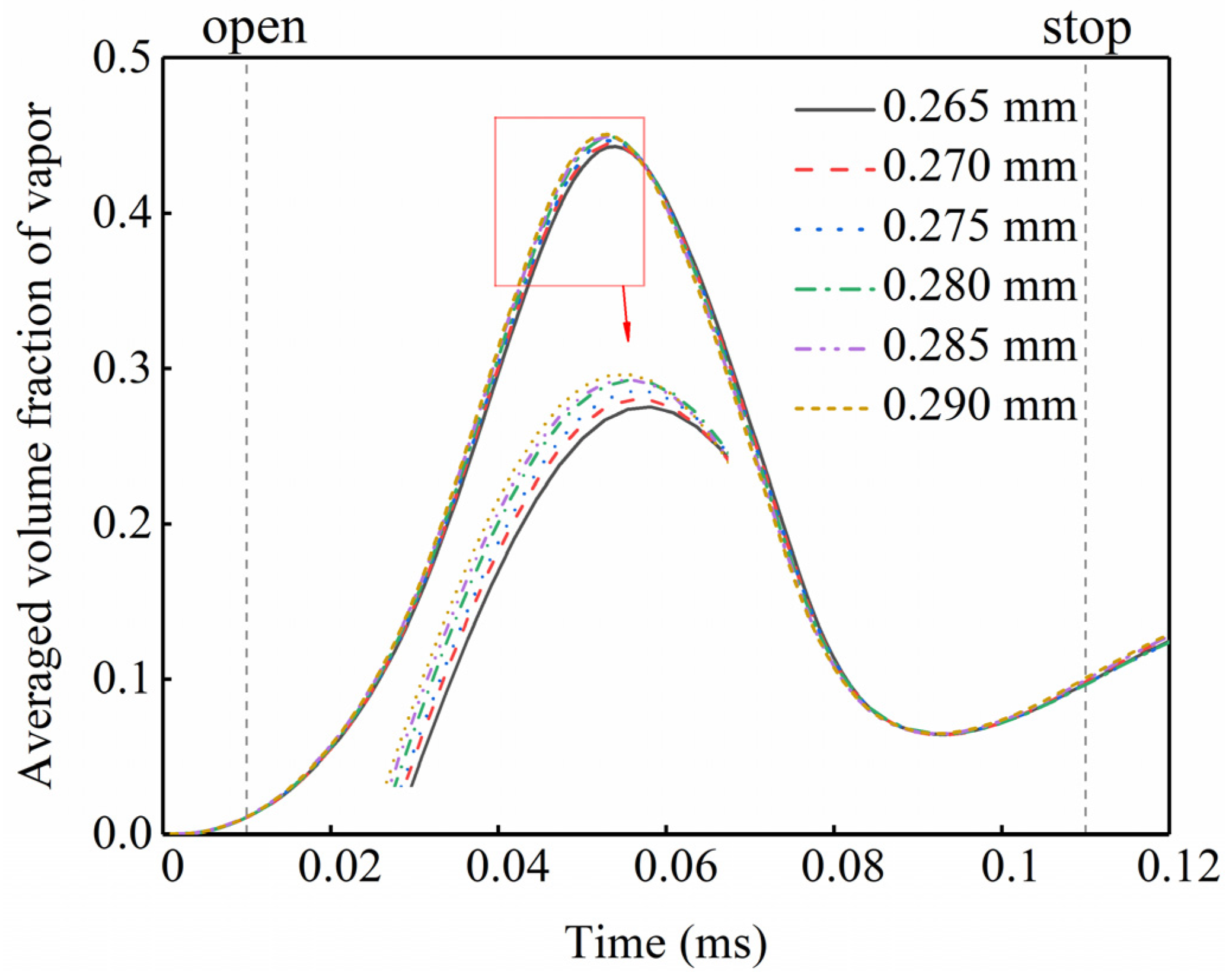
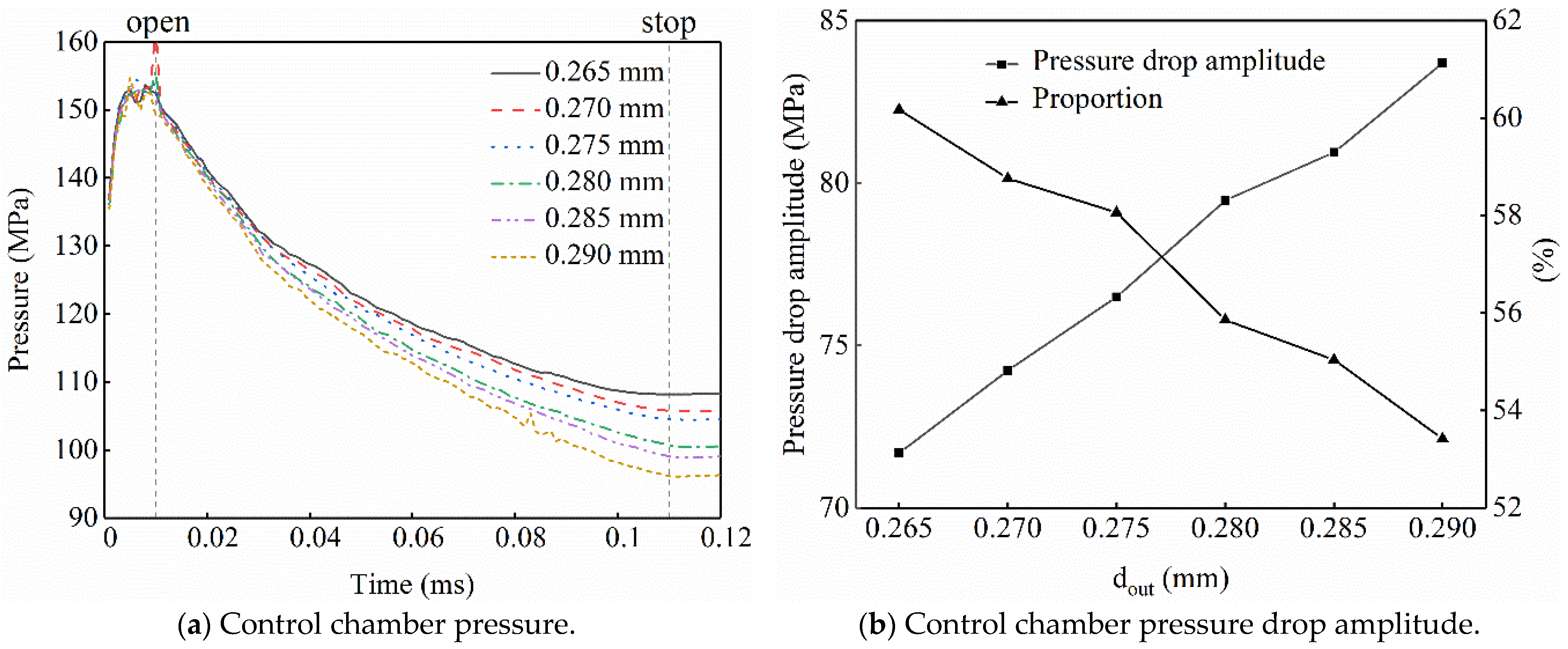
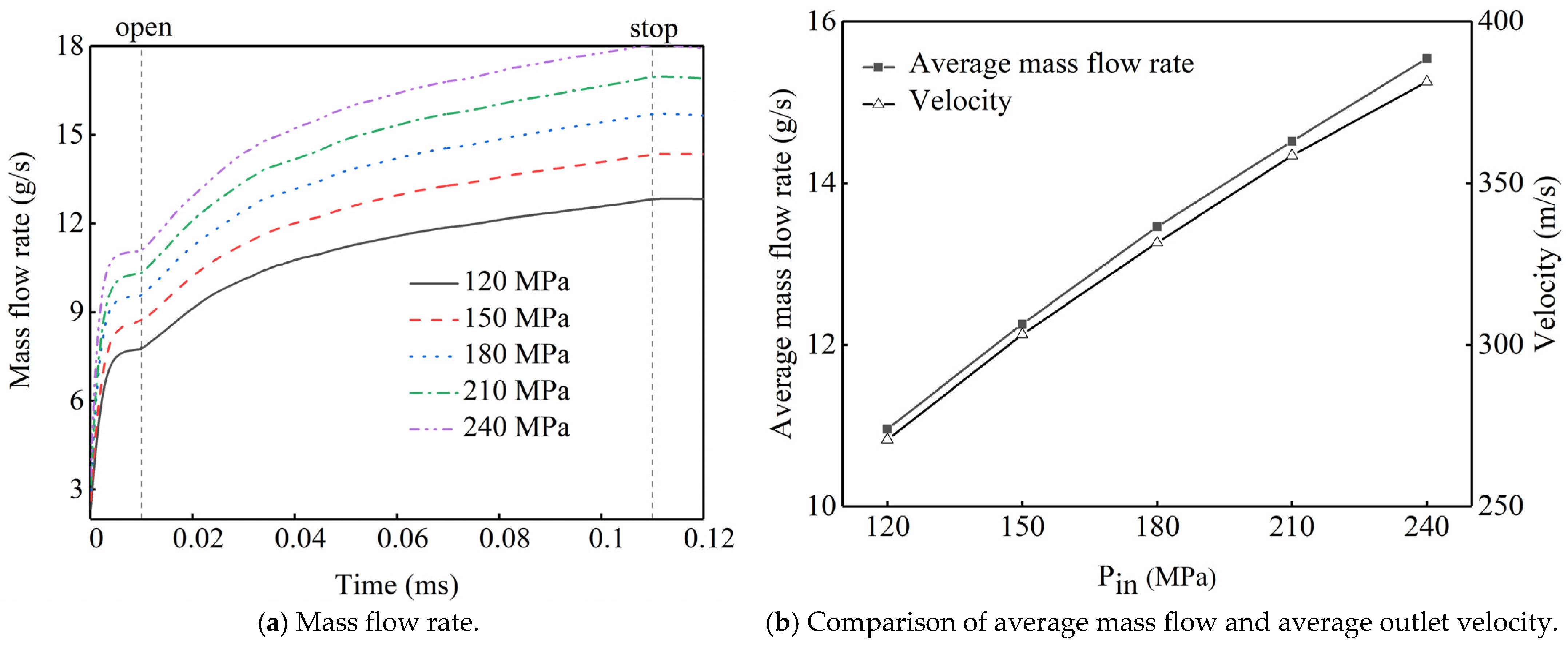
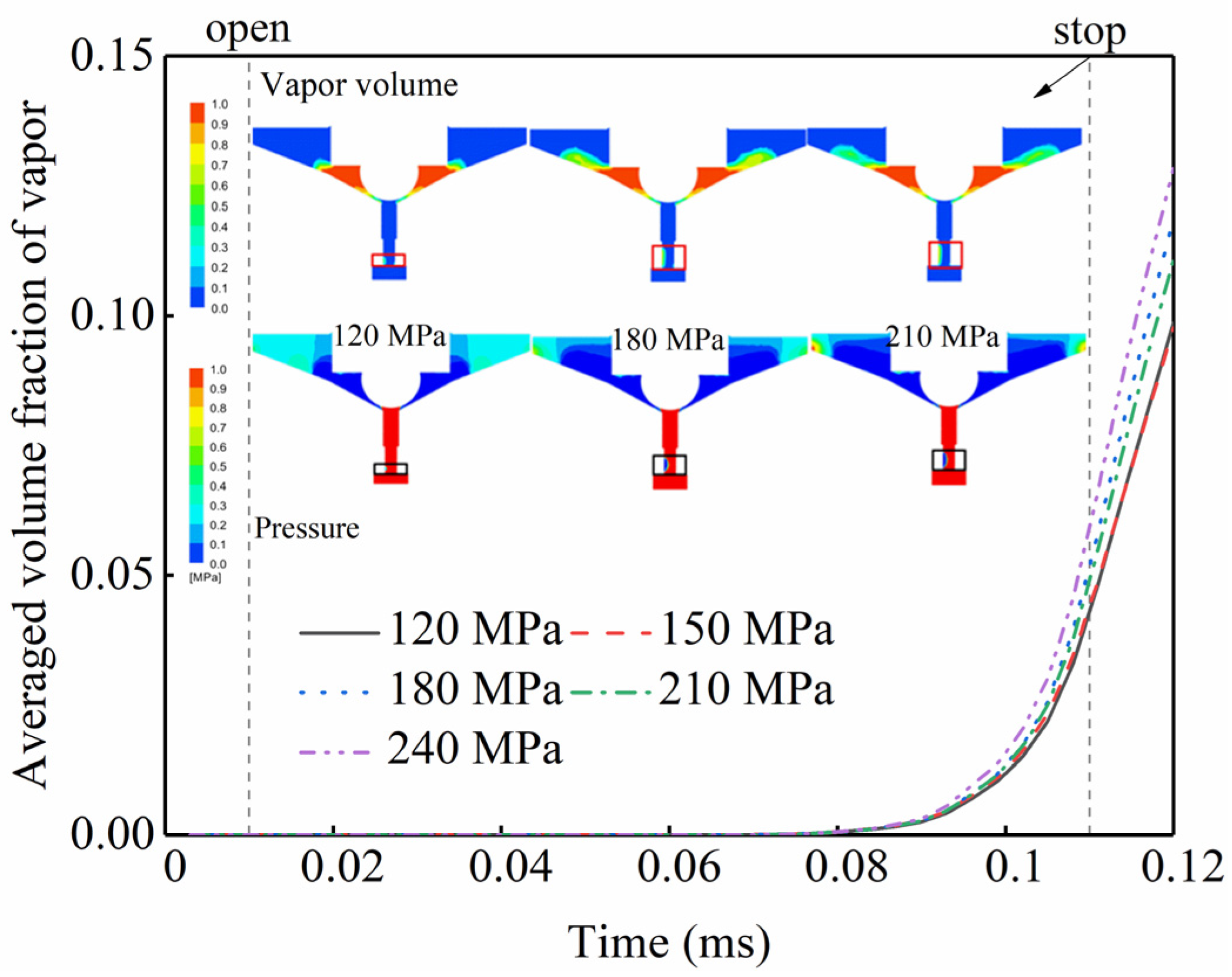



| Structure Name | Parameter Setting |
|---|---|
| Quality of spherical valve | 2.5 g |
| Diameter of spherical valve | 1.3 mm |
| Lift of spherical valve | 0.06 mm |
| Spherical valve seat angle | 120 deg |
| Aperture of OZ | 0.25 mm |
| Aperture of OA | 0.27 mm |
| Diameter of seat orifice | 0.35 mm |
| Name | Range | Accuracy |
|---|---|---|
| Experimental system test pressure | 300 MPa | ±0.6 MPa |
| EMI3-1500 | 600 mm3 | ±0.5 mm3 |
| Special fuel rail | 200,000 | |
| Siemens flowmeter | 1321 mL/min | 0.1% mL/min |
| Number | dout/mm |
|---|---|
| 1 | 0.265 |
| 2 | 0.270 |
| 3 | 0.275 |
| 4 | 0.280 |
| 5 | 0.285 |
| 6 | 0.290 |
Disclaimer/Publisher’s Note: The statements, opinions and data contained in all publications are solely those of the individual author(s) and contributor(s) and not of MDPI and/or the editor(s). MDPI and/or the editor(s) disclaim responsibility for any injury to people or property resulting from any ideas, methods, instructions or products referred to in the content. |
© 2022 by the authors. Licensee MDPI, Basel, Switzerland. This article is an open access article distributed under the terms and conditions of the Creative Commons Attribution (CC BY) license (https://creativecommons.org/licenses/by/4.0/).
Share and Cite
Ren, R.; Su, T.; Ma, F.; Yang, W.; Zhao, X.; Xu, C. Research on the Effect of the Outlet Throttle Diameter Deviation on the Pressure Relief Rate of the Injector Control Valve. Energies 2023, 16, 50. https://doi.org/10.3390/en16010050
Ren R, Su T, Ma F, Yang W, Zhao X, Xu C. Research on the Effect of the Outlet Throttle Diameter Deviation on the Pressure Relief Rate of the Injector Control Valve. Energies. 2023; 16(1):50. https://doi.org/10.3390/en16010050
Chicago/Turabian StyleRen, Rina, Tiexiong Su, Fukang Ma, Wei Yang, Xin Zhao, and Chunlong Xu. 2023. "Research on the Effect of the Outlet Throttle Diameter Deviation on the Pressure Relief Rate of the Injector Control Valve" Energies 16, no. 1: 50. https://doi.org/10.3390/en16010050






